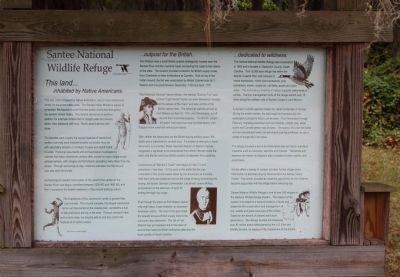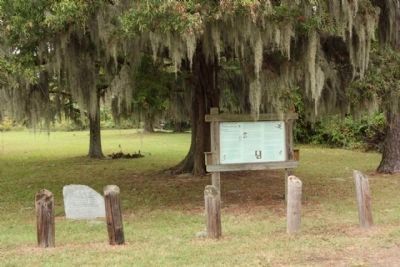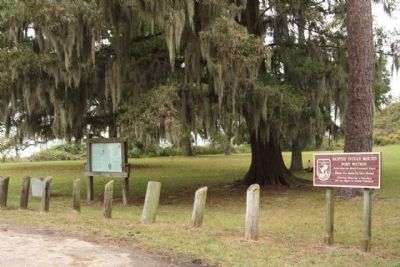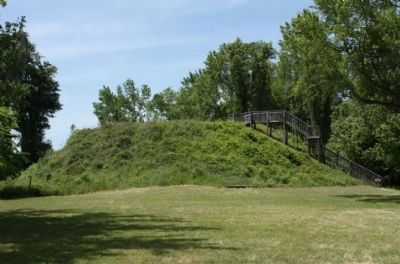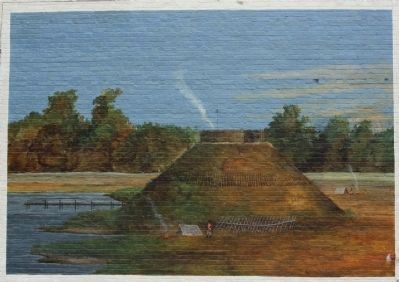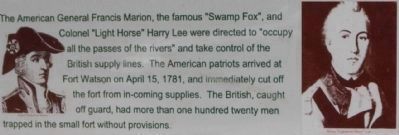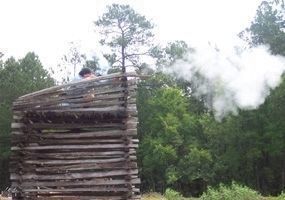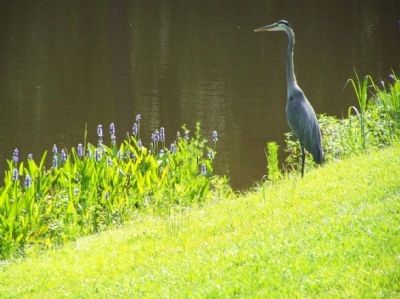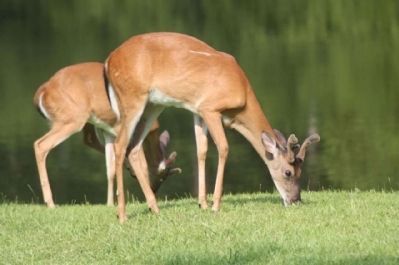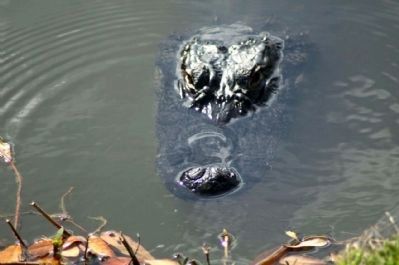Summerton in Clarendon County, South Carolina — The American South (South Atlantic)
Santee National Wildlife Refuge
inhabited by Native Americans.
This site, once occupied by Native Americans, was a major ceremonial center for the surrounding area. The Santee Indian mound is typical of pyramidal, flat-topped mounds that are widely distributed throughout the eastern United States. The mound served as an earthern platform for a temple constructed of upright posts and woven sticks, then plastered with mud. Roofs were thatched with straw.
The temples were usually the central features of ceremonial centers that may have included smaller but similar mounds with secondary temples or mortuary houses and round burial mounds. Historical documents and archaeological investigations indicate that these ceremonial centers often served as major religious and political centers, with villages and farmsteads spreading many miles from the center. Through archeological digs, evidence indicates that the mound was also used for burials.
Archaeologists suspect construction of this ceremonial center on the Santee River was begun sometime between 1200 AD and 1400 AD, and that it represents the eastern extension of the mound building culture.
The importance of this ceremonial center is greater than just one site. The mound complex, the largest ceremonial center yet discovered on the coastal plain, represents a hub of late prehistoric activity in the area. Through research here and at other sites, we may be able to one day outline the features of an entire culture.
[ Included 2 - 16th Century John White Native American Drawings]
(Center Text)
...outpost for the British.
Fort Watson was a small British outpost strategically located near the Santee River and the overland roads connecting the coast to the interior of the state. The location provided protection for British supply routes from Charleston to their fortifications at Camden. Built on top of the Indian mound, the fort was constructed by British Colonel John W.T. Watson and occupied between December, 1780 and April, 1781.
The American General Francis Marion, [ Picture included] the famous "Swamp Fox, and Colonel "Light Horse" Harry Lee were directed to "occupy all the passes of the rivers" and take control of the British supply lines. The American patriots arrived at Fort Watson on April 15, 1781, and immediately cut off the fort from in-coming supplies. The British, caught off guard, had more than one hundred twenty men trapped in the small fort without provisions.
With neither the Americans nor the British having artillery power, the battle was a stalemate for several days. Frustrated at attempts to force the ememy to surrender, Major Hezekiah Maham
of Marion's forces
suggested a log tower to be constructed from which riflemen could
fire down into the fort and force British soldiers to abandon their positions.
Construction of "Maham's Tower" was begun on April 21 and completed in two days. At this point in the battle the fort was vulnerable to the concentrated attack by the Americans at any time. With their defenses breached and on the verge of being stormed by the enemy, the British Garrison Commander, Lieutenant James McKay, surrendered on the afternoon of April 23, ending the eight day siege.
[Included picture: Harry "Lighthorse Harry" Lee]
Even though the action at Fort Watson lasted only eight days, it was however, an important American victory. The loss of this post made the already tenuous British supply lines to the upcountry less defensible. The fall of Fort Watson was an important link in the chain of events that made the British authorities abandon the back country of South Carolina.
(Right text)
... dedicated to wildness.
The Santee National Wildlife Refuge was established in 1942 and is located in Clarendon County, South Carolina. This 15,000 acre refuge lies within the Atlantic Coastal Plain and consists of mixed hardwoods, mixed pine-hardwoods, pine plantations, marsh, croplands, old fields, ponds and open water. This tremendous diversity
of habitat supports
many kinds of wildlife. The four management units of the refuge stretch
over 18 miles along the northern side of Santee Cooper's Lake Marion.
A myriad of wildlife species inhabit the varied landscape of Santee. During the winter months, the bald eagle and occasionally the endangered peregrine falcon can be seen. From November through February migrating waterfowl such as mallards, pintails, teal, wood ducks and Canada geeese [sketch included] may be seen.Throughout the year red-tailed and red-shouldered hawks can be viewed soaring overhead, as can a variety of songbirds in the trees.
The refuge provides a home for white-tailed deer and other woodland creatures such as raccoons,squirrels and bobcats. The ponds and marches are haven for alligators plus a number of other reptiles and amphibians.
Santee offers a variety of outdoor activities for the refuge visitor. Information on activities may be obtained from the Santee Visitor Center. The Center provides an excellent opportunity for the visitor to become acquainted with the refuge before venturing out.
Santee National Wildlife Refuge is one of over 500 refuges in the National Wildlife Refuge System. The mission of the system is to preserve a national network of lands and waters for the conservation and management of fish, wildlife and plant resources of the United States for the benefit of present and future generations. The Refuge System encompasses over 92 million acres administered by the U.S. Fish and Wildlife Service, an agency of the Department of the Interior.
Topics. This historical marker is listed in these topic lists: Animals • Environment • Forts and Castles • Native Americans • Notable Places • War, US Revolutionary • Waterways & Vessels. A significant historical month for this entry is April 1781.
Location. 33° 32.341′ N, 80° 26.193′ W. Marker is in Summerton, South Carolina, in Clarendon County. Marker is on Fort Watson Road (State Highway 14-803), in the median. Located at the pavements end, Santee Indian Mound - Fort Watson site. Touch for map. Marker is in this post office area: Summerton SC 29148, United States of America. Touch for directions.
Other nearby markers. At least 8 other markers are within 7 miles of this marker, measured as the crow flies. Fort Watson (a few steps from this marker); Swamp Fox (approx. half a mile away); 2nd Battle of Fort Watson (approx. half a mile away); a different marker also named Fort Watson (approx. half a mile away); Fort Watson: (approx. 0.8 miles away); Liberty Garden (approx. 3.6 miles away); Liberty Hill Church / Pioneers in Desegregation (approx. 4˝ miles away); Anne Custis Burgess (approx. 6˝ miles away). Touch for a list and map of all markers in Summerton.
Also see . . . Santee National Wildlife Refuge. U.S. Fish & Wildlife Service website entry (Submitted on April 26, 2010, by Mike Stroud of Bluffton, South Carolina.)
Credits. This page was last revised on March 1, 2022. It was originally submitted on April 26, 2010, by Mike Stroud of Bluffton, South Carolina. This page has been viewed 2,186 times since then and 30 times this year. Photos: 1, 2, 3, 4. submitted on April 26, 2010, by Mike Stroud of Bluffton, South Carolina. 5. submitted on October 27, 2009, by Mike Stroud of Bluffton, South Carolina. 6. submitted on April 26, 2010, by Mike Stroud of Bluffton, South Carolina. 7. submitted on October 27, 2009, by Mike Stroud of Bluffton, South Carolina. 8. submitted on November 10, 2009, by Mike Stroud of Bluffton, South Carolina. 9, 10, 11. submitted on April 26, 2010, by Mike Stroud of Bluffton, South Carolina.
